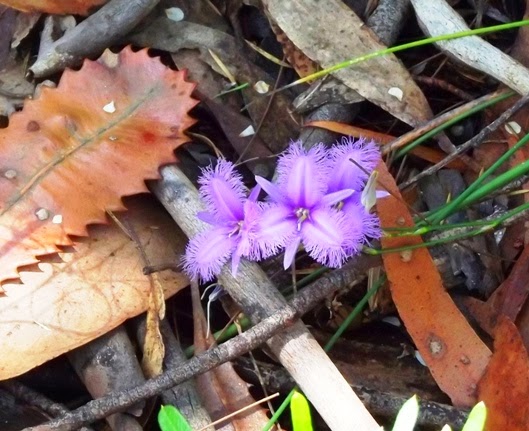In the period 1880-1910, a maze of walking tracks and
lookouts was developed in the Wentworth Falls Reserve under the supervision of
a local group of trustees. They were determined to provide access to as many
points of interest as possible and today’s tracks and lookouts are essentially
those developed at that time.
The present day Undercliff
and Overcliff Tracks meet at the bridge
over Den Fenella Creek, a point
easily reached from the western end of the Wentworth Falls Picnic Area. The
National Parks and Wildlife Service has spent a lot of time and effort in
rebuilding and restoring these historic tracks and it is only a few months
since the Den Fenella track was reopened with many good improvements.
 |
| Restored track |
For information on Den Fenella and the Undercliff Track, see
this blog entry.

From the bridge over the creek the track ascends to Lady See’s Lookout, then to Breakfast Point Lookout.

There is a link here to Murphy's Lane near the Conservation Hut. The Overcliff track continues to Lyre Bird Lookout, from
which another track ascends to the Short Cut Track. Close by is Queen Victoria Lookout, near the point where the descent into
the Valley of the Waters begins.
Otherwise, continue up the hill to the Conservation
Hut (for a well earned break at the café) or return to the Picnic Area
along the Short Cut Track.
Sir John and Lady See
bought "Yester Grange" at Wentworth Falls in 1902 as their country residence. At
that time Sir John was the Premier of New South Wales. Sadly, Lady See (born
Charlotte Mary Matthews) died in March 1904. Sir John resigned soon after and
died in 1907. The lookout was opened in 1904 at a ceremony attended by Sir
John. It had previously been known as “Picnic Point”.
 |
| Lady See's Lookout is closed |
At the time of writing, the lookout was closed and in need
of repair. It is to be hoped that the NP&WS will soon attend to this and
the repair and upgrading of the entire Overcliff Track, which is in need of
some serious maintenance work.
For the Wild Walks information on this walk click here.
For my video of this walk, click here. My Blue Mountains You Tube playlist is here . I have three other playlists - on gem hunting/mining, Glen Innes and New Zealand.
https://johnsbluemountainsblog.blogspot.com/2013/12/links-to-all-blog-entries-and-relevant.html
All Blue Mountains blogs and videos
All New England and other Geology blogs and videos
 |
| View Near Lady See's Lookout |

















